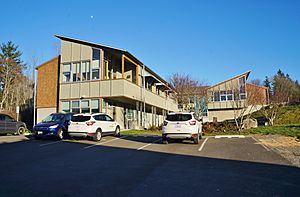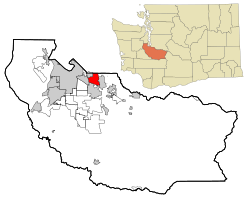Edgewood, Washington facts for kids
Quick facts for kids
Edgewood, Washington
|
|
|---|---|

City hall
|
|

Location of Edgewood, Washington
|
|
| Country | United States |
| State | Washington |
| County | Pierce |
| Government | |
| • Type | Mayor–council |
| Area | |
| • Total | 8.39 sq mi (21.74 km2) |
| • Land | 8.38 sq mi (21.72 km2) |
| • Water | 0.01 sq mi (0.02 km2) |
| Elevation | 354 ft (108 m) |
| Population
(2020)
|
|
| • Total | 12,327 |
| • Density | 1,556.71/sq mi (601.06/km2) |
| Time zone | UTC-8 (Pacific (PST)) |
| • Summer (DST) | UTC-7 (PDT) |
| ZIP codes |
98371, 98372, 98390
|
| Area code(s) | 253 |
| FIPS code | 53-20645 |
| GNIS feature ID | 1512179 |
Edgewood is a city in Pierce County, Washington, United States. It is a great place to live and learn!
In 2020, about 12,327 people called Edgewood home. The city is surrounded by other towns. To the west, you'll find Fife. Milton is to the northwest. If you head north, you'll reach Federal Way. To the east is Sumner, and to the south is Puyallup.
Contents
History of Edgewood
The story of Edgewood began with the Puyallup Indian tribe. They lived along the Puyallup River for a very long time.
In 1833, a Scottish doctor named William Fraser Tolmie visited the area. He worked for the Hudson's Bay Company. Trappers and settlers started moving to the area in the 1830s and 1850s.
Washington's first telegraph line was built through Edgewood. This line followed an old road called Military Road. By 1858, about 420 non-Native Americans lived in what is now Pierce County. This number grew to 681 by 1862.
The first school building in the North Hill area was a one-room log cabin. It opened in 1891 as School District 27. Peter Nyholm, one of the first known residents, arrived in Edgewood in 1895.
A special electric train line, called an interurban line, started running in October 1902. It connected Tacoma to Seattle, passing through the valley. A group called the State Spiritualists bought a summer camp in Edgewood in 1903. They started building a hotel there in 1927, but a fire destroyed it in 1948 before it was finished.
Edgewood officially became a city on February 28, 1996.
Geography of Edgewood
The areas of Edgewood and Milton are sometimes called North Hill. This name helps tell them apart from the South Hill area. South Hill is on the other side of the Puyallup River valley.
The city of Edgewood covers about 8.42 square miles (21.8 square kilometers). Most of this area is land, about 8.41 square miles (21.78 square kilometers). Only a tiny part, about 0.01 square miles (0.026 square kilometers), is water.
Population Information
| Historical population | |||
|---|---|---|---|
| Census | Pop. | %± | |
| 1990 | 8,677 | — | |
| 2000 | 9,089 | 4.7% | |
| 2010 | 9,387 | 3.3% | |
| 2020 | 12,327 | 31.3% | |
| U.S. Decennial Census 2020 Census |
|||
The population of Edgewood has grown over the years. In 2010, there were 9,387 people living in the city. There were 3,609 households, which are groups of people living together.
Most people in Edgewood identified as White (90.4%). Other groups included African American, Native American, Asian, and Pacific Islander. About 4.4% of the population identified as Hispanic or Latino.
The average age of people in Edgewood in 2010 was 44.3 years old. About 21.6% of residents were under 18 years old. Many adults, 34.9%, were between 45 and 64 years old.
Schools in Edgewood
Most students in Edgewood go to schools in the Puyallup School District. Some parts of the city are also served by the Fife Public Schools district or the Sumner School District.
There are four schools located right in Edgewood:
- Alice V. Hedden Elementary School is part of the Fife School District.
- Northwood Elementary School and Mountain View Elementary School are part of the Puyallup School District.
- Edgemont Junior High is also part of the Puyallup School District.
Nyholm Windmill
The Nyholm Windmill is a special historic landmark in Edgewood. It is located at 2284 Meridian Avenue East. This windmill used to be on a farm owned by Peter Nyholm. The farm grew hay, vegetables, fruits, and produced dairy products.
In 1980, the Edgewood Volunteer Fire Department helped move the windmill to its current spot. Today, the Nyholm Windmill is an important symbol for the city of Edgewood.
See also
 In Spanish: Edgewood (Washington) para niños
In Spanish: Edgewood (Washington) para niños

